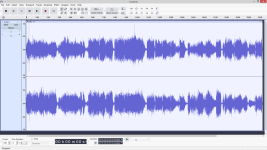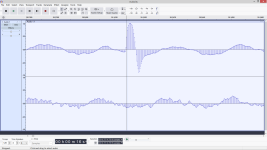No I don’t, but playing beloved LP’s that are no longer pristine annoys me.If you have 30 dB overload capability, cap coupling will never be a problem.
Hans
@Nick Sukhov, thanks for sharing document, as son as I manage to translate I'll read, sounds as interesting piece of history
Hi Hans, these worn Lp's will also damage stylus, expensive hobby if cart is hi end.So I’m thinking of designing a simple circuit between Phono Preamp and Preamp that removes pops and clicks
What about making cheap 2nd tt sistem from one of long time ago discarded tt's (I have BSR, or dual in mind) with some AudioTechnica cheap MM chart, still decent and no much damage to LP any more.
Still fun and music plays, clicks as part of experience, no worries about damaging anything that's not allready damaged or very cheap, just play w/o thinking and have fun?
Sorry, to continue, tone arm with changeable head shel is also perfect, or tt that can accommodate 2 arms is even better. One for pristine high end Lp's and chart, second for fun of all other records that appear
Thx,Yes, I am pleased to hand you the file
A very ingenious design.
Hans
Dear friends,
the topic has left me no peace, even though I theoretically know exactly how the SYSTEM should behave.
I have been measuring and testing the current Supra24 & Ruby3 side project for a good 2 hours now, using the wonderful HM407 analog/digital oscilloscope and corresponding function and pulse generator.
The result is quite shocking, namely the exact confirmation of the theoretical basics, the system and filter theory.
My DUT has an overload margin of 20dB. G1k = 40dB, +/-9Vdc supply ..!
There is no problem with jumps or impulses - zero, absolutely no problem at all. It doesn't matter how short or long the pulse is, etc.
For me personally, this case is now closed and will be filed away.
HBt.
the topic has left me no peace, even though I theoretically know exactly how the SYSTEM should behave.
I have been measuring and testing the current Supra24 & Ruby3 side project for a good 2 hours now, using the wonderful HM407 analog/digital oscilloscope and corresponding function and pulse generator.
The result is quite shocking, namely the exact confirmation of the theoretical basics, the system and filter theory.
My DUT has an overload margin of 20dB. G1k = 40dB, +/-9Vdc supply ..!
There is no problem with jumps or impulses - zero, absolutely no problem at all. It doesn't matter how short or long the pulse is, etc.
For me personally, this case is now closed and will be filed away.
HBt.
This Tomlinson Holman’s 1976 graph of peak signals from across a number of records. If 5mV/cm is used as the midband reference (typical cart output), the signal level out of the cart can be read directly in mV. The red trace is typical RIAA amp response in dB also read off the y-axis.
View attachment 1426028
Originally from an AES paper by Shure (except for red line).
Shows that their V15 could track virtually all commercial recordings.
There is the one and only problem - that the high output level from the phono preamp during the “click” will send the following power amplifier to saturation or overload its input stage. Nothing more, nothing less. And it is then not about phono preamp saturation.There is no problem with jumps or impulses - zero, absolutely no problem at all. It doesn't matter how short or long the pulse is, etc
🙂 fully understand how you feel !Dear friends,
the topic has left me no peace, even though I theoretically know exactly how the SYSTEM should behave.
I have been measuring and testing the current Supra24 & Ruby3 side project for a good 2 hours now, using the wonderful HM407 analog/digital oscilloscope and corresponding function and pulse generator.
The result is quite shocking, namely the exact confirmation of the theoretical basics, the system and filter theory.
My DUT has an overload margin of 20dB. G1k = 40dB, +/-9Vdc supply ..!
There is no problem with jumps or impulses - zero, absolutely no problem at all. It doesn't matter how short or long the pulse is, etc.
For me personally, this case is now closed and will be filed away.
HBt.
LP just defeats common rules.
This thread has a title with two topics:
1) RIAA Overload Performance’ to Encoded Signals (i.e. the Music) and
2) Response to Clicks and Pops (Unencoded)
Point 1) can be regarded as being a non issue with modern phono preamps, but
Point 2) is still an interesting subject, at least to me.
When Drbulj is right, one should avoid playing LP's with pops and clicks with expensive carts.
Or maybe I should buy a (ultrasonic) record cleaner to remove debris from within the tracks, also causing pops and clicks.
Hans
1) RIAA Overload Performance’ to Encoded Signals (i.e. the Music) and
2) Response to Clicks and Pops (Unencoded)
Point 1) can be regarded as being a non issue with modern phono preamps, but
Point 2) is still an interesting subject, at least to me.
When Drbulj is right, one should avoid playing LP's with pops and clicks with expensive carts.
Or maybe I should buy a (ultrasonic) record cleaner to remove debris from within the tracks, also causing pops and clicks.
Hans
You pointed one subject that is rather missed on this mighty diyaudio.com forum. It is probably more important than anything else in not new 180g or 240g audiophile LP replay.Or maybe I should buy a (ultrasonic) record cleaner to remove debris from within the tracks, also causing pops and clicks
I would add another one; reply of pre riaa records. I'm lucky to have about 25 Lp's of early jazz recordings (before ww2) which are recut from still alive master tapes, but not adjusted to riaa. Each has different eq and speed to the matter of fact. It would be lovely to hear sound from jazz in time of prohibition in us, how it sounded then.
My observation is that clicks and pops are hardly noticable on a tube RIAA preamplifier, that has passive (interstage) frequency correction, no feedback. On the other hand, clicks and pops can be very disturbing on an operational amplifier based RIAA preamplifier that uses correction in the feedback. Both are flat to +/- 0.1 dB, the opamp based pre has >20 dB overload margin, and still... Subjectively they are completely different, the tube unit suppresses clicks, the opamp unit emphasizes them. It is hard to find the reason by measuring them, but immediately evident by listening to them. I don't mention models or schematics, it seems related to the active devices.
Here is Shure's public domain "HIGH FIDELITY PHONOGRAPH CARTRIDGE - TECHNICAL SEMINAR"
which includes several detailed trackability graphs, and some difficult to find papers. From:
https://service.shure.com/s/article...technical-seminar?language=en_US®ion=en-US
which includes several detailed trackability graphs, and some difficult to find papers. From:
https://service.shure.com/s/article...technical-seminar?language=en_US®ion=en-US
Attachments
This must be a design issue. I have no problem with disturbances from clicks and grossly prefer the feedback RIAA design.On the other hand, clicks and pops can be very disturbing on an operational amplifier based RIAA preamplifier that uses correction in the feedback
https://pmacura.cz/openphono.htm
An hour ago I finished some archive digitizing of LPs. Below is an example of a "bad" click, that still is not much subjectively disturbing.
 and zoomed
and zoomed 
Last edited:
Unfortunately, I don't have a tube amplifier to hand, so I'll have to use another representative:My observation is that clicks and pops are hardly noticable on a tube RIAA preamplifier, that has passive (interstage) frequency correction, no feedback. On the other hand, clicks and pops can be very disturbing on an operational amplifier based RIAA preamplifier that uses correction in the feedback. Both are flat to +/- 0.1 dB, the opamp based pre has >20 dB overload margin, and still... Subjectively they are completely different, the tube unit suppresses clicks, the opamp unit emphasizes them. It is hard to find the reason by measuring them, but immediately evident by listening to them. I don't mention models or schematics, it seems related to the active devices.
Wayne Colburn's Pearl Phonostage Number 1, the only true original.
#
Overload margin less than 20dB, on my specimen it is exactly 15.66dB in relation to 5mVrms and G1k 100.
Everything is still set up, so let's get to work - no problems at all with jumps or impulses. Whether short or long, single or periodic - the Pearl processes everything according to theory, and in an exemplary manner.
However, if we look very critically, we can see marginal differences in the time signal (domain) compared to the symmetrical core of the Supra24 and the single-ended class A stages of the Pearl 1.
What is the reason for this (I'm not asking myself, of course)?
HBt.
Me neither!This must be a design issue. I have no problem with disturbances from clicks and grossly prefer the feedback RIAA design.
🙂👍
and also prefer allInOne EQ (nfb one).
Agree Hans. But perhaps a sub subject of this thread could be 'why design phono amps using topogies that only offer 9 dB overload?'This thread has a title with two topics:
1) RIAA Overload Performance’ to Encoded Signals (i.e. the Music) and
2) Response to Clicks and Pops (Unencoded)
Point 1) can be regarded as being a non issue with modern phono preamps, but
Point 2) is still an interesting subject, at least to me.
When Drbulj is right, one should avoid playing LP's with pops and clicks with expensive carts.
Or maybe I should buy a (ultrasonic) record cleaner to remove debris from within the tracks, also causing pops and clicks.
Hans
The circuit was copied from a datasheet, unaware that the manufacturer had never tried it.Bonsai said:But perhaps a sub subject of this thread could be 'why design phono amps using topogies that only offer 9 dB overload?'
Ed
No criticism intended towards anyone here - I'm thinking more of the stuff on Stereophile etc. Like the great feedback debate, many (most?) commerceial phono amps eschew single-stage RIAA topologies and go for active/passive in some form, with many of them highly compromised.
- Home
- Source & Line
- Analogue Source
- RIAA Overload Performance’ to Encoded Signals (i.e. the Music) and Response to Clicks and Pops (Unencoded)